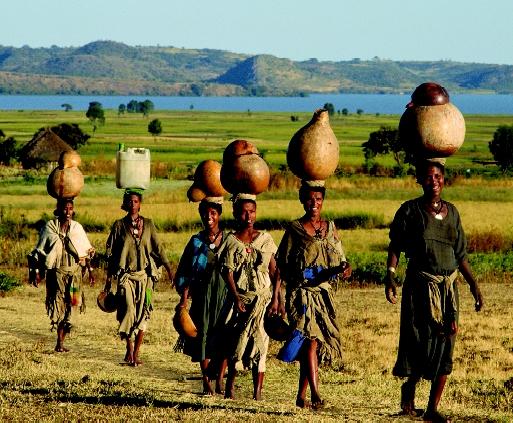
ONCE A FAMINE VICTIM, COULD ETHIOPIA NOW BECOME AN AFRICAN BREADBASKET?
By Vincent Defait
LE TEMPS/Worldcrunch
LE TEMPS/Worldcrunch
Despite the largest livestock head count on the African continent, a series of nagging problems prevent Ethiopia from realizing its agricultural potential. But now, the government in Addis Abeba has a plan to turn the country from famine poster child to a net food exporter.
ADDIS ABEBA - The cross-bred “Dutch” cows have changed his life. Since the Ethiopian government gave him the black and white bovine, which are able to produce several dozen liters of milk a day, Kefne Bermeje has been able to make profits, buy other stock to fatten, build a new house and send his seven children to school. The change is revolutionary. In Debre Zeit, a one-hour-drive south from the capital, this farmer now oversees a herd and produces enough cereal to feed his family and save money.
His situation belies the spreading alarms about the coming wet season with lean production outputs expected for the Horn of Africa. Earlier this month, the US agency Famine Early Warning System Network (FEWS NET) warned that “the severity and scale of food insecurity can rise very quickly.”
But what if, despite the poor rainfall, Ethiopia stopped importing thousands of tons of foodstuff and attempted to reverse the trend? What if Ethiopia actually became an exporter of food? It is not science fiction: this country’s food production potential is huge.
Africa’s water tower
Ethiopia is indeed to East Africa what Switzerland is to Europe: a virtual water tower. Its rivers cut across vast areas of potential arable land, which nevertheless has been left idle since it lacks irrigation. Few people know that with its 50 million bovine, 25 million sheep and 22 million goats, Ethiopia has Africa’s largest collection of livestock, and the tenth biggest in the world. As for foreign markets, the wealthy oil-producing Gulf States are close by…
The resources are underestimated and underexploited as another drought looms. Whether we are talking about agriculture, meat or milk, “our production and our productivity remain very low”, says Admealem Shitaye of the Ministry of Agriculture. He blames “traditional practices, bovine breeds with low genetic potential and a livestock trade that is not market-oriented enough.”
Azage Tegegne, a researcher at the International Livestock Research Institute (ILRI), agrees: “It is true that if you compare the Ethiopian livestock and the way these resources are used, you have a terrible paradox,” he says. “I recently travelled to the Netherlands with my research team. They were stunned to see that with only 1.8 million dairy cows, the country is flooding Europe with high-quality milk — and it’s produced in a responsible way!”
So why couldn’t Ethiopia do the same? The problem is, here, the bovine is a treasure. Slaughtering cows to produce meat is out of the question, and dairy breeds are struggling to produce more than one liter a day. When they can afford to buy a cow, peasant farmers would rather buy a beast of burden that they will use for ten years before sending it on the meat market. This is far too late to produce quality meat.
How could the problem be solved? “If you boost the agricultural productivity with fertilizers, a greater control of seeding times and a certain mechanization, you can guarantee food security to the farmers. They would feed their cattle better, which in turn could be used for other means,” Azage Tegegne explains. Then you have artificial insemination and the import of more productive European breeds.
Leasing land
With a new and quite ambitious Growth and Transformation Plan (GTP), the Ethiopian government expects to quadruple the number of the highly productive cross-bred stock in the national livestock by 2015. Meanwhile, 3.3 billion hectares will be leased for a low price to foreign investors, who have been given the mission to industrialize Ethiopian agriculture. Could it be a way for the country to be self-sufficient, and maybe even a net exporter? “There is no doubt about it,” Admealem Shitaye maintains. He reminds us that the country is aiming to join the club of emerging countries by 2025.
But we are not there yet. In the area surrounding Debre Zeit, Firehiwot Gezagn, the owner of five good dairy cows, complains about the falling milk and meat prices. The long Easter fast, which is well-observed in Ethiopia, is to blame. But the mother of four has found another way to make ends meet: since she bought a television, crowds are drawn to her farm to watch Champions League soccer matches.
With a 3 birr (0.12 euros) entrance fee, the beautiful game offsets her food-market losses. “I host between 20 and 30 people when Manchester United or Chelsea are playing. Other teams don’t bring much of a crowd,” she says. On this particular point, there isn’t much the Ethiopian government can do.
No comments:
Post a Comment